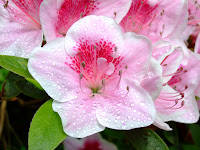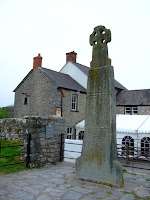 Ljubljana has a crisp old centre with many elegant buildings. This is due to the efforts of a 20th century architect called Jože Plečnik. His most well known legacy is the triple bridge and colonnades used, when we visited, for an antiques market. We bumped into his work in a number of places on our trip including an altar and a tabernacle in two churches.
Ljubljana has a crisp old centre with many elegant buildings. This is due to the efforts of a 20th century architect called Jože Plečnik. His most well known legacy is the triple bridge and colonnades used, when we visited, for an antiques market. We bumped into his work in a number of places on our trip including an altar and a tabernacle in two churches.
The very recently opened funicular railway took the effort out of climbing up to the high bluff above the town, to visit the castle.
Ljubljana is small and compact and we spent the morning on a trail of discovery of Plečnik buildings.
 One of the more fascinating, off the main tourist route, discoveries we made, was his monument to celebrate the point where the river left the town. He dressed up some utilitarian sluice gates into a triumphal arch for the waters that leave the city.
One of the more fascinating, off the main tourist route, discoveries we made, was his monument to celebrate the point where the river left the town. He dressed up some utilitarian sluice gates into a triumphal arch for the waters that leave the city.Weary with architecture and hot streets, we decided to head out to the mountains, taking the northeast route out of town to Kamnik.
 This seemed very quiet after Ljubljana: a perfect place to unwind. North of the town, we took a cable car followed by a chair lift to Velika Planina, a plateau at the top of the mountain (1666m). It was described as the perfect place for an effortless alpine stroll. The most fascinating feature was the herdsmen's huts: we were a few weeks early, but in June, the herdsmen will arrive with their herds to graze the alpine meadows.
This seemed very quiet after Ljubljana: a perfect place to unwind. North of the town, we took a cable car followed by a chair lift to Velika Planina, a plateau at the top of the mountain (1666m). It was described as the perfect place for an effortless alpine stroll. The most fascinating feature was the herdsmen's huts: we were a few weeks early, but in June, the herdsmen will arrive with their herds to graze the alpine meadows. Once off the mountain, we visited a nearby arboretum. This had a French parterre, an English garden, a rose garden and forest. It was a beautiful evening to enjoy the long warm Summer day.
Once off the mountain, we visited a nearby arboretum. This had a French parterre, an English garden, a rose garden and forest. It was a beautiful evening to enjoy the long warm Summer day.We had spotted a very picturesque village on the trip up the valley, so went back to explore: the churchyard was fascinating;
 every plot has a very manicured garden with lit candles or LEDs. They all looked like display gardens from the Chelsea Flower Show (just on a smaller scale). Having looked at a few other cemeteries in Slovenia, this appears to be the norm, although we never saw another one to match this first one. The time and cost expended to keep these graveyards looking like this must be amazing, unlike the typical English churchyard, not a single plot appeared unloved.
every plot has a very manicured garden with lit candles or LEDs. They all looked like display gardens from the Chelsea Flower Show (just on a smaller scale). Having looked at a few other cemeteries in Slovenia, this appears to be the norm, although we never saw another one to match this first one. The time and cost expended to keep these graveyards looking like this must be amazing, unlike the typical English churchyard, not a single plot appeared unloved. We had expected Kamnik to show some signs of life in the evening so headed back for dinner. We only found one place open, maybe because it was Sunday evening. They managed to serve Murray the wrong meal, so he got to eat two meals.
We had expected Kamnik to show some signs of life in the evening so headed back for dinner. We only found one place open, maybe because it was Sunday evening. They managed to serve Murray the wrong meal, so he got to eat two meals.Second impression of Slovenia is that the drivers are madmen. Rules such as no cellphone use; obeying speed limits; keeping to your own side of the road; and observing ‘no passing’ restrictions clearly do not apply to the locals.
































